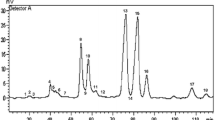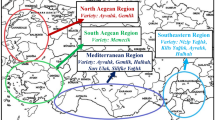Abstract
Sterols, which comprise a major portion of the unsaponifiable matter, are found in almost all fats and oils and are also characteristic of the purity of vegetable oils. Recently, some works have proposed that sterol profiles can be used to classify virgin olive oils according to their fruit variety. Throughout this work, the mean values of each sterol compound of olive oils extracted from several cultivars were submitted to Principal Component Analysis (PCA) and Hierarchical Cluster Analysis (HCA) in a discriminatory fashion. Results confirm that phytosterols can differentiate between varieties, hybrids and oleasters. Always the two first principal components were sufficient to explain the variability between olive cultivars. The PCA shows a clear discrimination between all studied samples. Therefore, the composition of sterols was found to be sufficient for the olive oil discrimination, characterization and adulteration with lower priced oils.
Access this chapter
Tax calculation will be finalised at checkout
Purchases are for personal use only
Similar content being viewed by others
References
Baccouri B., Manai H., Sánchez-Casas J. Osorio E., Zarrouk M.: Tunisian wild olive (Olea europaea L. subsp. oleaster) oils: sterolic and triterpenic dialcohol compounds. Ind. Crops. Prod. 120, 11–15 (2018)
Ben Mohamed, M., Rocchetti, G., Montesano, D., et al.: Discrimination of Tunisian and Italian extra-virgin olive oils according to their phenolic and sterolic fingerprints. Food Res. Int. 106, 920–927 (2018)
IOOC, International Olive Oil Council (2013). Determination of the composition and content of sterols and triterpene dialcohols by capillary column gas chromatography; COI/T 20/ Doc. No. 30/Rev. 1
Lukic, M., Lukic, I., Krapac, M., Sladonja, B., Pilizota, V.: Sterols and triterpene diols in olive oil as indicators of variety and degree of ripening. Food Chem. 13, 251–258 (2013)
Manai-Djebali, H., Oueslati, I., Martínez-Cañas, M.A., Zarrouk, M., Sánchez-Casas, J.: Improvement of the sterol and triacylglycerol compositions of Chemlali virgin olive oils through controlled crossing with Mediterranean cultivars. J. Oleo Sci. 67(4), 379–388 (2018)
Manai-Djebali, H., Krichene, D., Ouni, Y., Gallardo, L., Sánchez, J., Osorio, E., Daoud, D., Guido, F., Zarrouk, M.: Chemical profiles of five minor olive oils varieties grown in Central Tunisia. J. Food Compos. Anal. 27, 109–119 (2012)
Oueslati, I., Manai, H., Mahjoub-Haddada, F., Daoud, D., Zarrouk, M.: Sterol, triterpenic dialcohol and triacylglycerol compounds of extra virgin olive oils from some Tunisian varieties grown in the region of Tataouine. Food Sci. Technol. Int. 15(1), 5–13 (2009)
Sakouhi, F., Absalon, C., Harrabi, S., Vitry, C., Sebei, K., Boukhchina, S., Fouquet, E., Kallel, H.: Dynamic accumulation of 4-desmethylsterols and phytostanols during ripening of Tunisian Meski olives (Olea europea L.). Food Chem. 112, 897–902 (2009)
Sanchez-Casas, J., Osorio Bueno, E., Montano Garcıa, A.M., Martinez Cano, M.: Sterol and erythrodiol + uvaol content of virgin olive oils from cultivars of Extremadura (Spain). Food Chem. 87, 225–230 (2004)
Sönmez, A., Özdikicierler, O., Saygin Gümüşkesen, A.: Evaluation of olive oil quality during ripening of organic cultivated olives and multivariate discrimination of variety with a chemometric approach. Riv Ital Sostanze Gr 95, 173–181 (2018)
Vichi, S., Pizzale, L., Toffano, E., Bortolomeazzi, R., Conte, L.: Detection of hazelnut oil in virgin olive oil by assessment of free sterols and triacylglycerols. J. AOAC Int. 84, 1534–1541 (2001)
Author information
Authors and Affiliations
Corresponding author
Editor information
Editors and Affiliations
Rights and permissions
Copyright information
© 2021 The Editor(s) (if applicable) and The Author(s), under exclusive license to Springer Nature Switzerland AG
About this paper
Cite this paper
Manai-Djebali, H., Oueslati, I., Baccouri, B., Harzalli, Z., Martínez-Cañas, M.A., Sánchez-Casas, J. (2021). Importance of Phytosterols in the Classification of Tunisian Olive Cultivars: Discrimination Between Varieties, Hybrids and Oleasters. In: Ksibi, M., et al. Recent Advances in Environmental Science from the Euro-Mediterranean and Surrounding Regions (2nd Edition). EMCEI 2019. Environmental Science and Engineering(). Springer, Cham. https://doi.org/10.1007/978-3-030-51210-1_174
Download citation
DOI: https://doi.org/10.1007/978-3-030-51210-1_174
Published:
Publisher Name: Springer, Cham
Print ISBN: 978-3-030-51209-5
Online ISBN: 978-3-030-51210-1
eBook Packages: Earth and Environmental ScienceEarth and Environmental Science (R0)




